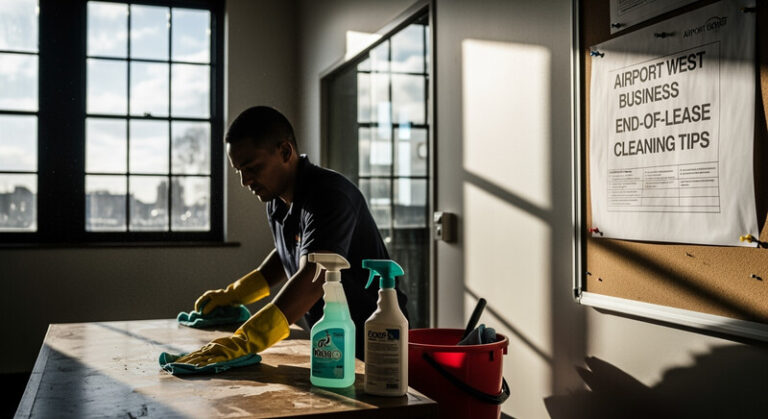
Handing back a commercial space in Airport West can be stressful, especially when juggling final rent, removals, and the pressure to pass a rigorous make‑good inspection. A structured, landlord‑friendly cleaning plan helps protect the bond, prevents re‑clean call‑backs, and keeps the handover timeline on track. This guide breaks down a practical, step‑by‑step process tailored to offices, retail suites, and light industrial units in Airport West, so the premises present as professionally as they operate.
Understand your lease, make‑good, and scope
Revisit the lease and make‑good clause: Many commercial leases in Airport West require returning the premises to “base building” condition or to a defined handover state. Clarify what’s “clean,” what’s “repaired,” and what’s “removed” to avoid scope gaps.
Confirm inclusions/exclusions: Ask the agent or landlord for their preferred cleaning checklist, inspection standards, and any building-specific rules (e.g., loading dock booking, waste disposal limits, or after‑hours access).
Align with outgoing condition report: If there was an entry condition report, align your cleaning scope to that baseline. Where improvements were made (e.g., extra meeting rooms or shelving), note whether removal and patch/paint are required before cleaning.
Build a realistic move‑out cleaning timeline
Back‑plan from handover: Work backwards from the inspection time. Book removals first, repairs next (patch/paint, glazing, tile/grout fixes), then deep clean. Leave a final buffer day for touch‑ups.
Sequence by dust: Dirty jobs first (demolition, patching, sanding), light repairs next, fittings removal after, and deep clean last. This prevents re‑soiling and duplicated effort.
Reserve lift/loading dock slots: In busy Airport West precincts, secure building access for cleaning crews and waste removal to avoid delays.
Room‑by‑room end‑of‑lease cleaning checklist
Reception and offices
Ceilings and vents: Dust and vacuum vents, diffusers, and acoustic tiles; remove cobwebs. Wipe sprinkler covers and detector surrounds without tampering.
Lighting: Dust fittings, wipe lens covers, and replace failed globes if the lease requires “all in working order.”
Walls, doors, and glass: Spot‑clean scuffs, remove adhesive and tape, clean finger marks on doors and frames, and polish internal glazing/partitions.
Workstations: Wipe desks, cable trays, monitor arms, and credenzas; remove labels and residue. Vacuum under raised floors if accessible.
Windows: Clean interior glass, tracks, and sills; arrange exterior glass if it falls under tenant obligations.
Floors: Vacuum carpet edge‑to‑edge; rotary shampoo or hot‑water extraction for stains. For vinyl, laminate, or timber, vacuum, mop with pH‑appropriate cleaner, and buff if required by the lease.
Meeting rooms and breakout areas
Whiteboards and AV: Clean whiteboards, remove marker ghosting, wipe remotes, and dust projectors and speakers.
Chairs and tables: Wipe frames and seats, clean table undersides (often missed), and sanitize high‑touch points.
Kitchen/tea point
Appliances: Degrease and detail microwave (inside/out), refrigerator (defrost, sanitize, deodorize), dishwasher filter and seals, kettle and coffee machines as applicable.
Cabinets and benchtops: Empty and disinfect all cupboards and drawers; polish stainless steel. Remove liners and food residues.
Splashbacks and sinks: Descale taps and spouts; scrub sinks, polish drains, and remove limescale and tea/coffee marks.
Floors and drains: Degrease floors near appliances; clear debris from floor wastes and wipe skirtings.
Toilets and washrooms
Fixtures: Descale bowls and urinals, sanitize seats and lids, polish cistern buttons and partitions.
Basins and taps: Remove limescale and soap scum; polish chrome to a smear‑free finish.
Mirrors and dispensers: Clean mirrors streak‑free; wipe exterior of soap and towel dispensers.
Tiles and grout: Scrub grout lines, especially behind fixtures; remove any mildew.
Floors: Disinfect mop with neutral‑pH cleaner; detail mop edges and behind doors.
Server rooms and sensitive areas
Dry methods only: HEPA vacuum floors and accessible surfaces; avoid wet mopping near racks.
Cable management: Remove temporary labels and Velcro debris; do not disturb infrastructure not under tenant control.
Retail frontage and display areas
Shopfront glass: Clean inside thoroughly; coordinate external glass based on center rules.
Fixtures: Detail shelving, slatwalls, and display tables; remove adhesives and price tag residue.
Fitting rooms: Sanitize touchpoints, mirrors, hooks, and skirtings; vacuum edges.
Warehouse/light industrial (if applicable)
High dusting: Dust purlins, conduit, and ledges where safe; consider scissor lift if within scope and permitted.
Roller doors and docks: Clean door slats, controls, and seals; remove grease marks.
Concrete floors: Scrub with auto‑scrubber if needed; remove tire marks and spot‑degrease oil stains.
Racking: If racking is removed, sweep and detail bolt holes per make‑good terms.
Common missed items that trigger re‑cleans
Skirting boards, architraves, and door tops: Wipe for dust and scuffs.
Switch plates, thermostats, and access panels: Fingerprints and grime are easy wins to fix.
Window tracks and frames: Vacuum, grit, and wipe clean; remove dead insects and debris.
Blinds: Dust slats or vacuum fabric blinds on low suction; spot‑clean stains where permitted.
Air returns and ceiling fans: Dust buildup is visible during inspections.
Appliance cavities: Pull out fridges and microwaves; clean sides, backs, and floors underneath.
Sticker residue: Use safe adhesive removers on glass, steel, and melamine; test first.
Waste areas: Empty and disinfect all bins; remove cardboard stacks and pallet wrap.
Odors: Address the source, ventilate, and use enzyme‑based deodorizers rather than heavy fragrance.
Stains and specialty surfaces: quick tactics
Carpet spots: Treat coffee, tea, and toner with the right chemistry. Blot, never scrub. Escalate to hot water extraction for wicking stains.
Glass and stainless: Use microfiber and the two‑cloth method for streak‑free finishes; finish stainless with the grain.
Stone benchtops: Avoid acidic products on marble/terrazzo; use pH‑neutral stone cleaner to prevent etching.
Vinyl floors: Skip harsh degreasers that strip polish; consult the manufacturer if the lease requires returning to a polished finish.
Health, safety, and building compliance
After‑hours cleaning: Many Airport West sites prefer evening or weekend work. Ensure the team has access cards, alarm codes, and an on-site contact.
Electrical and ladders: Follow working‑at‑heights and isolation procedures; never open ceiling spaces unless authorized.
Waste streams: Separate general, cardboard, and e‑waste. Some centers require proof of off-site disposal—keep dockets.
Quality control: how to pass the first time
White‑glove walkthrough: Do a slow, methodical inspection at eye‑level and from kneeling height. Check edges, corners, and reflective surfaces under bright light.
Photo evidence: Capture before/after photos of high‑risk areas (kitchen appliances, bathrooms, carpets, window tracks) to document standards met.
Agent pre‑inspection: If possible, request a quick pre‑handover look from the property manager to catch preferences early.
DIY vs professional: choosing wisely
Go DIY if: The space is small, the traffic light, and the repairs are minimal. Assign a team lead, divide the checklist, and build a firm timeline with accountability.
Hire pros if: There’s heavy foot traffic wear, kitchen/amenities buildup, window height access, or compressed timelines. Re‑cleans cost time; seasoned teams move faster with the right gear.
For businesses on tight schedules, local expertise can be invaluable. When outsourcing, consider experienced cleaners with proven end‑of‑lease results and transparent scopes. For reliable support, professional cleaners Airport West can take on deep cleans, appliance and glass detailing, carpet treatment, and handover touch‑ups ahead of inspection.
Cost and budgeting tips
Fixed scope, fixed fee: Request a line‑item scope (rooms, windows, appliances, floors) with a fixed price and a re‑clean guarantee that aligns to the inspection report.
Allocate contingency: Reserve 10–15% for stain removal, unexpected repairs, or additional waste runs.
Bundle services: Ask about adding carpet steam‑cleaning, high glass, or pressure washing to reduce total cost and scheduling complexity.
Sustainability and low‑disruption practices
Low‑odor products: Choose low‑VOC chemicals to keep the air fresh for any overlapping staff activity.
Reuse and donate: Redirect usable office items to local charities; reduce landfill and potential removal costs.
Microfiber systems: Color‑coded microfiber reduces cross‑contamination and improves finish quality on glass and stainless.
Handover day: a final checklist
Keys and access: Collect all keys, fobs, and passes, labeled and counted.
Meters and readings: Record final electricity, gas, and water reads if required.
Proof of works: Keep invoices for cleaning, carpet, windows, and waste removal with dates and contacts.
Walkthrough pack: Provide the agent with a simple folder of receipts, product MSDS (if requested), and before/after photos.
Practical sample schedule (medium office, 300–500 m²)
T‑7 to T‑5: De‑fit non‑base items, patch/paint, minor repairs.
T‑4: High dusting, vents, lights; kitchen appliances degreased.
T‑3: Window interiors, glass partitions, and blinds.
T‑2: Amenities deep clean; carpets pre‑treat; hard floors scrub.
T‑1: Final vacuum/mop; touch‑ups; odor control; white‑glove walkthrough.
T‑0: Handover inspection, re‑clean (if any) within the guarantee window.
Airport West nuances to remember
Mixed tenancies: Many premises combine office plus warehouse or retail frontage; tailor the scope to each zone’s wear patterns and surfaces.
Access windows: Some business parks limit noisy works; plan carpet extraction and auto‑scrubbing at approved times.
Parking and lifts: Reserve parking close to entries for efficient equipment loading and waste removal.
Conclusion
A successful commercial end‑of‑lease clean in Airport West is less about frantic scrubbing on the last day and more about a clear plan, smart sequencing, and attention to the small details property managers notice first. Align the scope with the lease, schedule cleaning after dusty works, and verify quality with a meticulous walkthrough. For teams that prefer certainty over scramble, engaging seasoned local help ensures a smooth, bond‑safe handover—professional cleaners airport west can deliver the finish and documentation that satisfy even the most exacting inspections.



